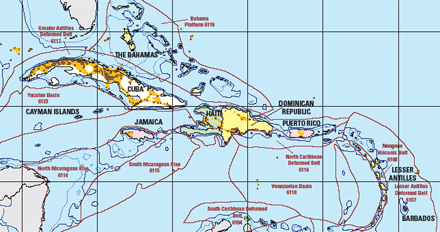Circular 1288
Published 2007 |
Statistics of Petroleum Exploration in the World Outside the United States and Canada Through 2001By Emil D. Attanasi, Philip A. Freeman, and Jennifer A. Glovier |
Abstract |
 Map showing oil and gas exploration through 2001 in the Caribbean. Future oil and gas supplies depend, in part, on the reserves that are expected to be added through exploration and new discoveries. This Circular presents a summary of the statistics and an analysis of petroleum exploration in the world outside the United States and Canada (the study area) through 2001. It updates U.S. Geological Survey Circular 1096 (by E.D. Attanasi and D.H. Root, 1993) and expands coverage of the statistics to areas where drilling and discovery data have recently become available. These new areas include China, the formerly Communist countries of Eastern Europe, and the countries that once were part of the former Soviet Union in Europe and Asia. Data are presented by country but are organized by petroleum provinces delineated by the U.S. Geological Survey World Energy Assessment Team (USGS Digital Data Series DDS–60, published in 2000). The data and analysis are presented in maps and graphs, providing a visual summary of the exploration maturity of an area. The maps show the delineated prospective areas and explored areas through 2001; explored areas have a drilling density that would rule out the occurrence of undetected large petroleum accumulations. Graphs summarize the exploration yields in terms of cumulative recoverable discovered oil and gas by delineated prospective area. From 1992 through 2001 in areas outside the United States and Canada, the delineated prospective area expanded at a rate of about 50,000 square miles per year while the explored area grew at the rate of about 11,000 square miles per year. The delineated prospective area established by 1970 contains about 75 percent of the oil discovered to date in the study area. This area is slightly less than 40 percent of the delineated prospective area established through 2001. Maps and graphs show the extension of the delineated prospective area to deepwater areas offshore of Brazil and West Africa. From 1991 through 2000, offshore discoveries accounted for 59 percent of the oil and 77 percent of the gas discovered in the study area. The petroleum industry's decision to incur the greater costs of moving offshore and into deeper waters appears to be a response to the absence of onshore prospects of comparable quality. Where natural gas can be commercially developed and marketed, data show an expansion of exploration to target gas-prone areas. |
Report |
Download the report in Portable Document Format (PDF). Circular 1288 (23.6MB) To view and print Portable Document Format (PDF) files you will need Adobe Reader software. Download the latest version of Adobe Reader, free of charge. |
Suggested Citation |
| Attanasi, E.D., Freeman, P.A., and Glovier, J.A., 2007, Statistics of petroleum exploration in the world outside the United States and Canada through 2001: U.S. Geological Survey Circular 1288, 167 p. |
Contact |
| For scientific questions or comments, please send inquiries to Emil D. Attanasi (E-mail address: attanasi@usgs.gov). |